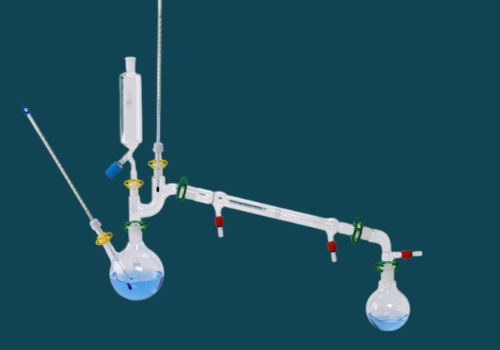

Pyrex Quickfit jointed glassware
Distillation, extraction, filtration and reflux processes require various complexities of laboratory glassware assemblies, using interchangeable jointed glassware. This safety blog will cover the various types of jointed glassware available, and explore basic techniques for its safe maintenance.
Pyrex Quickfit jointed glassware
Jointed glassware can help avoid spills and leaks of potentially harmful, and often valuable, substances during experiments. It is important to select the right type of jointed glassware for the process you are carrying out. There are a number of joins, each with their own specific functionality:
1) Conical joints
Conical is the most common type of ground glass joint, and features a tapered cone and socket. Sockets of this kind often feature a rounded rim profile, which gives additional strength to the joint whilst making them less prone to chipping than a square rim profile.
2) Spherical joints
Spherical joints should be used for techniques where you require some flexibility in the angles of the glassware being connected together. These are commonly used to connect receiving flasks to rotary condensers, where the weight can increase significantly as the flask fills. This joint allows the flask to be connected to a sloping condenser at a vertical angle which reduces the strain placed on the joint.
3) Flange joints
Flange joints (or butt joints) are used to provide straight line connections along assemblies. This joint is commonly used for pipeline constructions and on large capacity flasks and reaction vessels. The ability to use wider flange joints provides easier access to the contents of flasks and tubes.
4) Screw thread joints
Screw thread joints provide a strong but easily adjustable connection. They are ideal where the length of an assembly might need to be varied, a sliding joint can be employed to achieve this. Double ended screw cap glassware is also commonly used, enabling lines to be adjusted from either side for even greater flexibility.
How to operate jointed glassware safely
There are some basic steps to follow to ensure safe, sustainable use of jointed glassware. It is important to always wash new glassware before its first use to avoid contamination from packaging fibres. You should also examine the glassware to ensure its not scratched, chipped, cracked or etched as any defects will reduce the mechanical strength of the glassware and may cause it to break during use.
There are a number of specific considerations to ensure safe handling and repeated use of jointed glassware:
- Silicone grease can be used to help seal a joint, but many joints are designed to be used without it to avoid contamination. A cleaner and non-contaminating alternative is the use of a PTFE joint sleeve that fits between the cone and socket joints
- Always check the maximum temperature guidelines for the equipment you are using. For example, even though the maximum temperature of borosilicate glass is 500°C (for short periods only), any other items associated with the joint (plastic connections, stoppers, tubing etc) could be much lower
- If using a hotplate, ensure that the top plate is larger than the base of the vessel to be heated, and never put cold jointed glassware onto a pre-heated hotplate
- When using temperatures above 150°C, heating and cooling should be carried out in a slow and uniform manner to avoid breakage by thermal shock
If using a hotplate, ensure that the top plate is larger than the base of the vessel to be heated, and never put cold jointed glassware onto a pre-heated hotplate - When using a Bunsen burner, employ a soft flame and use a wire gauze with a ceramic centre to diffuse the flame. This will avoid creating ‘hot spots’ on the joints or anywhere else in the assembly to prevent breakage
- Do not apply high temperatures/heat sources directly to any item of volumetric accuracy especially in jointed glassware as this will impair the volumetric accuracy
- Take care when using jointed glassware in a microwave. If the glassware is made from borosilicate glass then this element will be microwave safe. Care must be taken to ensure the contents and any attachments are also microwave safe
- Jointed glassware can occasionally seize after use. If this happens, the jointed glassware should be allowed to cool naturally and should then be immersed for a short period of time in lukewarm water containing a suitable detergent for cleaning glassware. This will loosen the seized jointed and should allow you to disconnect the elements without having to apply excess pressure to the glass. It is important that this is avoided to ensure the glass does not break or is not damaged ahead of subsequent re-use.
All blog information was provided courtesy of DWK, all our Quickfit glassware by DWK can be found here











































